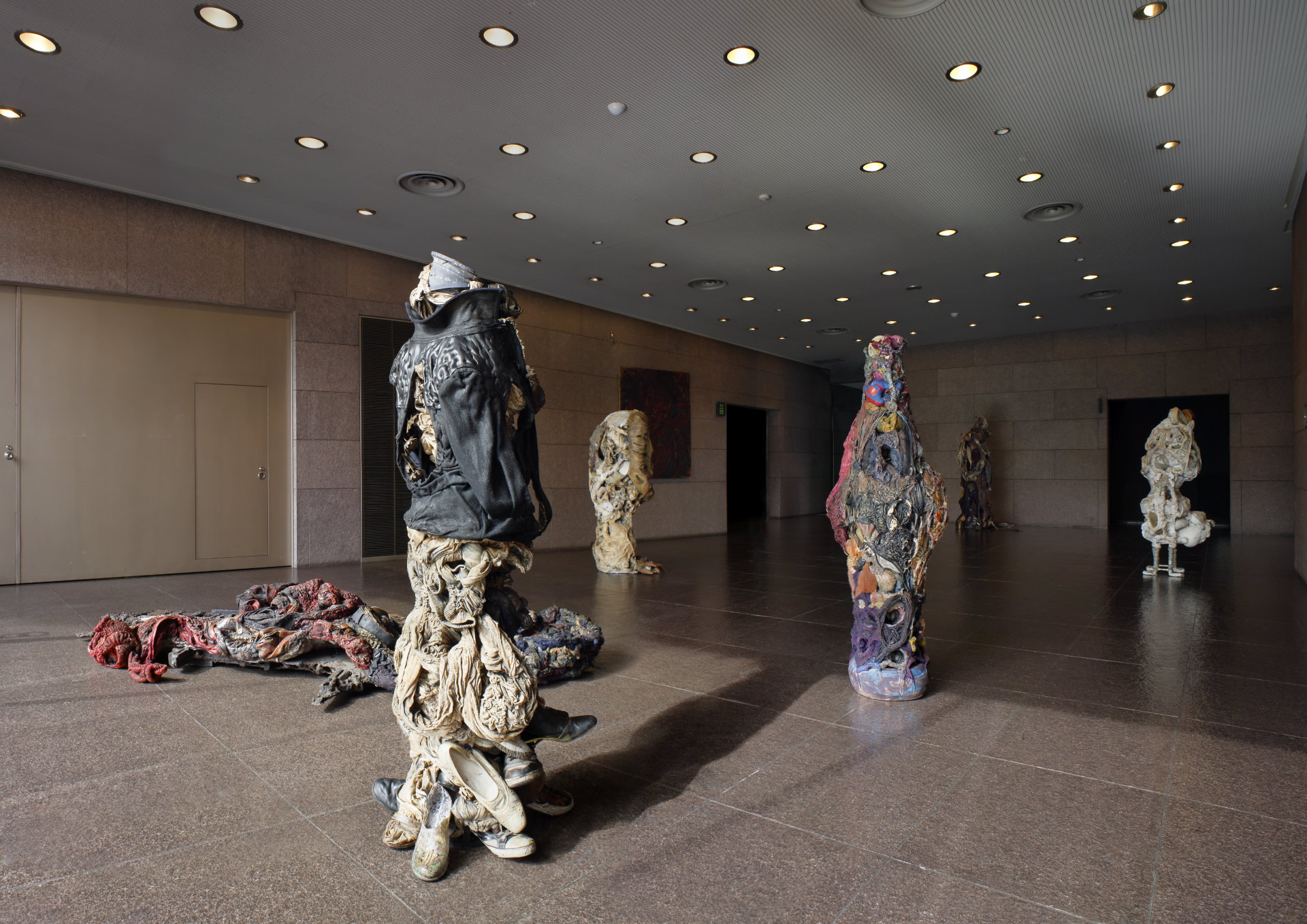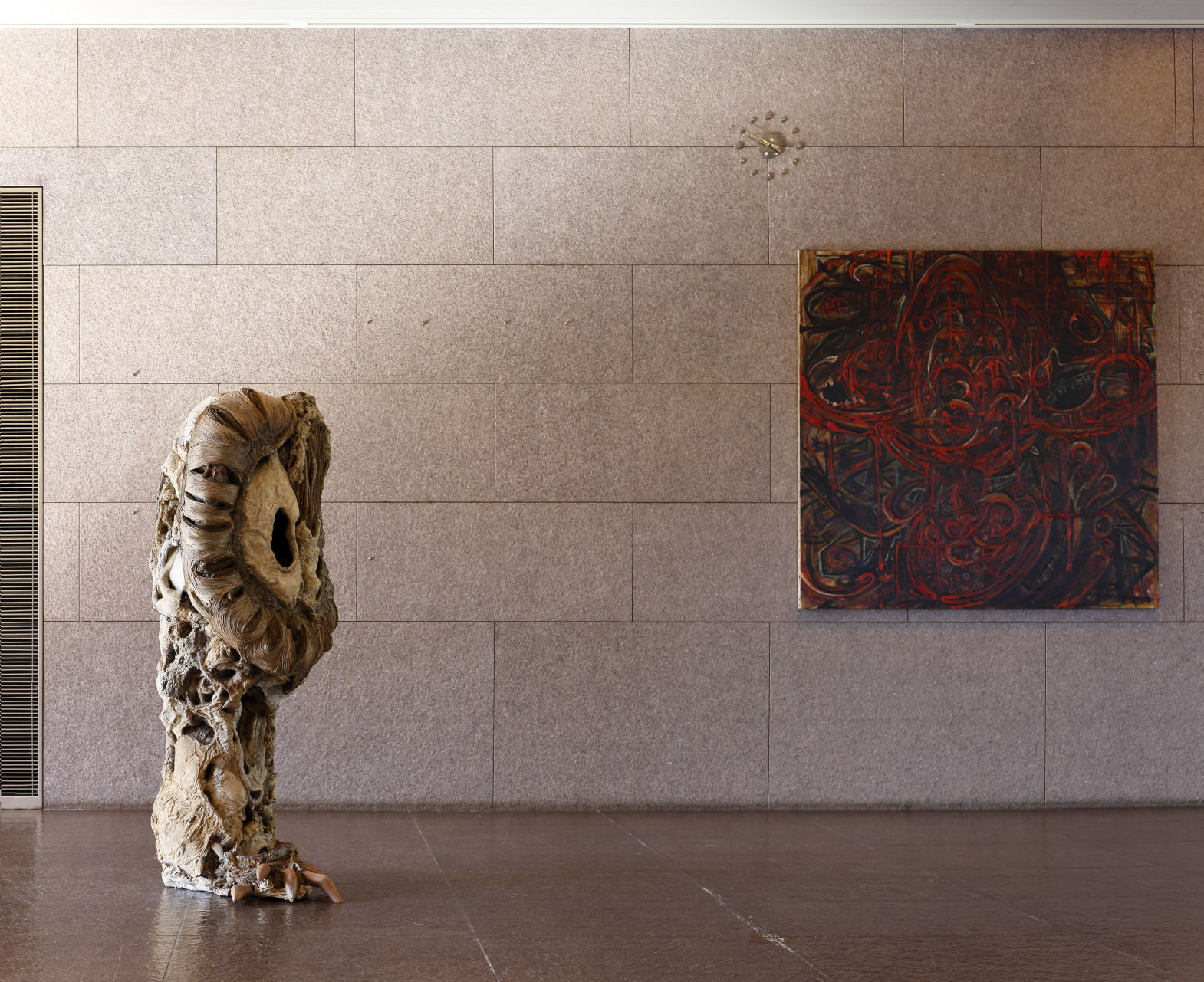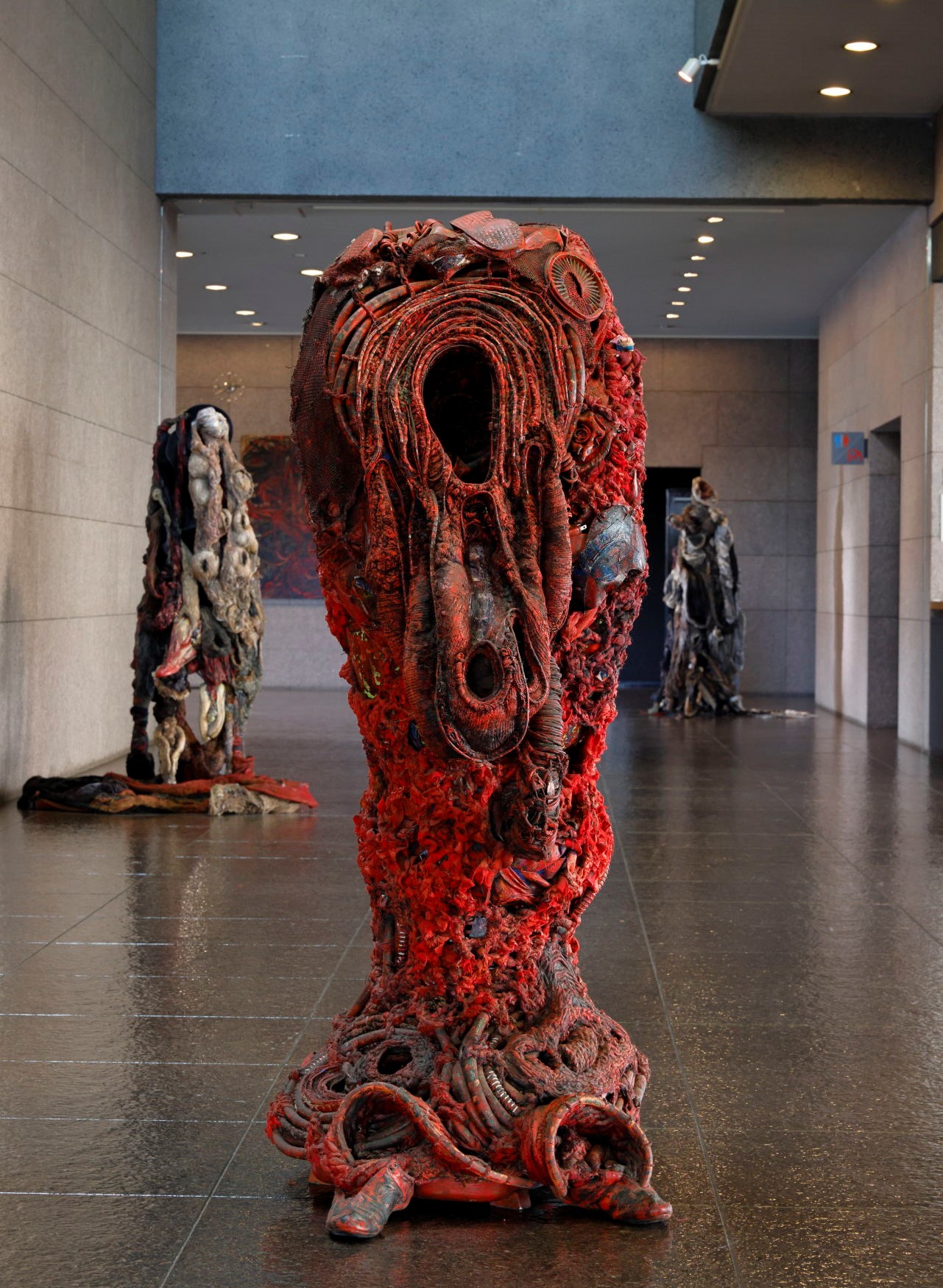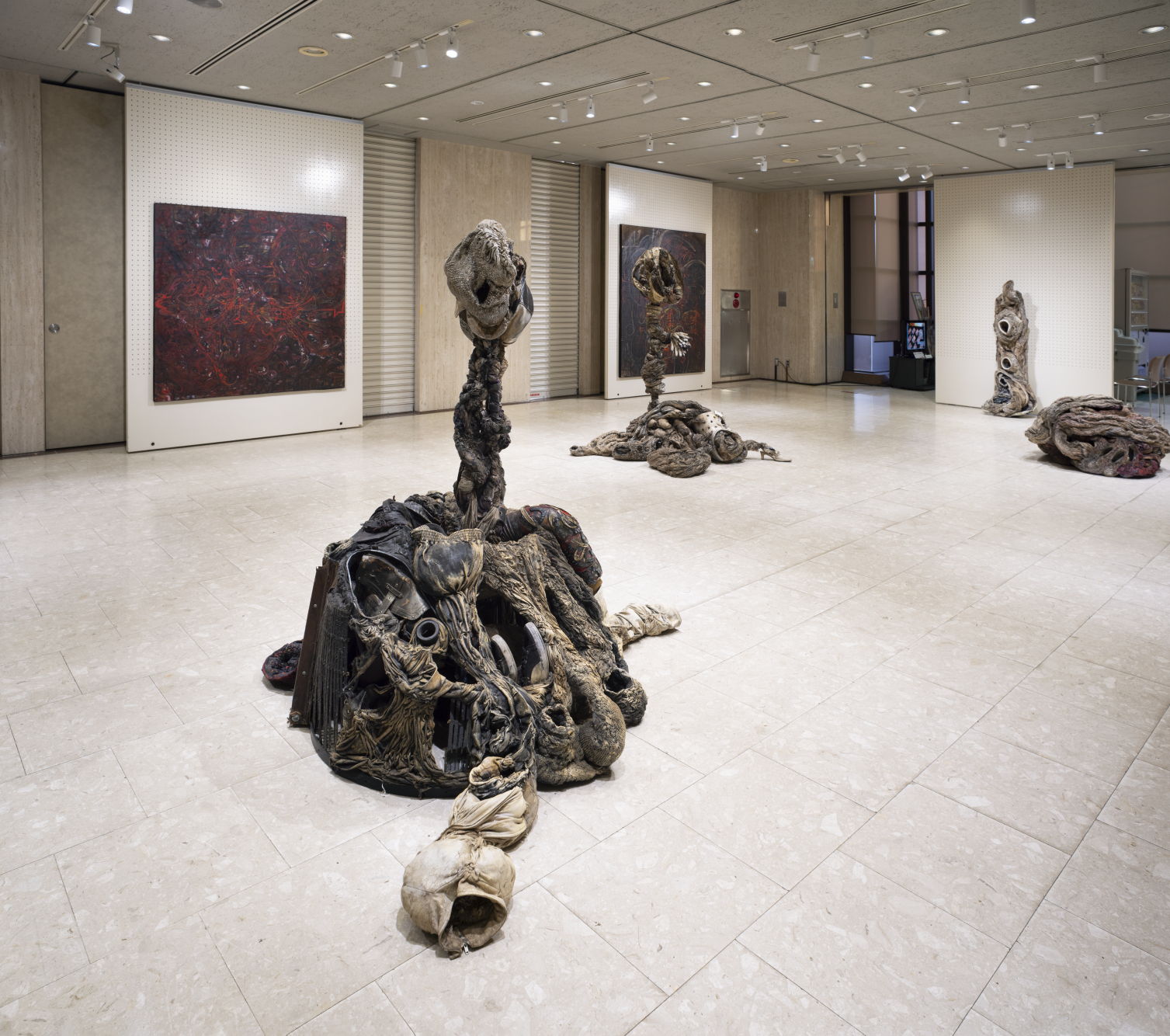西成田洋子 NISHINARITA Yoko

《記憶の森2021》 2021年 ミクストメディア 355×1550×650cm インスタレーション いわき市立美術館
Forest of Memory 2021, 2021, Mixed media, 355×1550×650cm, Installation at the Iwaki City Art Museum
西成田洋子
NISHINARITA Yoko
1953年 茨城県水戸市生まれ。水戸市に在住、活動。
曝け出された臓器
平野明彦(いわき市立美術館特任学芸員)
日常生活のなかで用いられる生活消費財は、身の回りに存在することから私たちの身体と近接した関係にある。そして上記の品々のなかでも特に衣類や靴は、直接手足や肌身に接するという意味で極めて身体的な存在と言える。例えばシルクのブラウスのスベスベとした心地良い肌触りや、履き下ろしたばかりの革靴やハイヒールによって擦れた皮膚のヒリヒリとした痛みというイメージは、皮膚感覚を通して得た触覚の記憶によって引き起こされるのであり、おそらく西成田にとって上記の品々との接触は、身体の様々な感覚器官に起因する記憶の断片をもたらしていると思われる。
そして生活消費財は、人に使われ、時を経ることを通して次第に劣化し、やがて商品としての価値や有用性を失っていく。劣化とは消費社会における価値観から下された言葉だが、劣化を通して生活消費財は、商品という名の均一化、記号化された衣を脱ぎ捨て、個としての時間を宿したモノへと変容したと解釈すれば、モノに宿された時間の痕跡 ― すなわちジャンパーやセーター等の衣類にみられる色褪せ、綻び、破れ、さらに革靴やハイヒール等の傷は、言わばモノに付与された記憶の徴として、モノと時間、モノと人との身体的な関わりを想起させる。
つまり記憶という観点から解釈すれば、西成田にとって日常生活のなかで用いられてきた品々とは、廃棄物や消費財として類型化された作品素材ではなく、時間の経過、人との関係によって自らの、そして他者の身体に関わる時間と記憶を付与されたモノなのであろう。そして西成田は、モノとしての姿を現し始めた品々との直接的な接触による生理的な感応を通して、身体の諸感覚のなかで最も原始的な感覚とも言うべき内臓感覚を揺り動かされ、おそらくその揺らぎは、身体にまつわる根源的な記憶の古層にも及んでいるのではなかろうか。
「ニューアートシーン・いわき、西成田洋子 記憶の森」展リーフレット、いわき市美術館、2021より一部抜粋
Born in Mito city, Ibaraki, Japan in 1953. Lives and works in Mito.
The Exposed Organs
Akihiko Hirano, Curator, Iwaki City Art Museum
Our bodies are in a close relationship with the consumer goods we use in our daily lives, because they always exist around us. And among them, clothes and shoes are extreme physical existences from the perspective that they directly touch our bodies and limbs. The smooth, pleasant touch of a silk blouse, or the sore skin caused by the friction of wearing brand new leather shoes or high heels—such images arise from a tactile sensory memory perceived via cutaneous sensation. Thus, it can be surmised that coming in contact with those articles allowed Nishinarita to perceive fragmental memories that originated from various sensory organs of her body.
Everyday consumer goods gradually deteriorate through the passage of time and steady use, while also eventually losing their value and utility as commodities. The use of the term “deterioration” is applied based on the sense of value in our consumer society. Such a state of deterioration allows consumer goods to cast off the homogenized and symbolized images that have been applied to commodities. They are then transformed into “things,” each of which contains its own unique passage of time. Based on this interpretation, the traces of the time embedded in a “thing” would allow one to recall the physical relationships between “the thing and its passage of time” or “the thing and the person,” seen as the indications of a memory given to “the thing.” Those traces of time are manifested in such images as faded colors, frays, and rifts in clothes that are found in jackets and sweaters, or also as scratches in leather shoes and high heels.
In other words, if we were to interpret her works from the perspective of “memory,” we would understand that Nishinarita does not consider articles used in everyday life to be art materials that are categorized under “disposable waste” or “consumer goods.” Rather, she regards them as “things” that have been ingrained with the traces of time and memories involving her own body or those of others, through the passage of time and the relationships between “things” and people. Such articles stimulate her visceral sensation, seen as the most primeval and fundamental sensory organ out of our various physical sensations. She perceives this via the physiological response caused by directly coming in contact with the articles that had begun revealing their appearances as “things.” And that sensation she feels likely extends to the depths of the primordial memories related to the body.
Translated by NANPEI Taeko
Excerpt from the leaflet of the exhibition, New Art Scene in Iwaki, YOKO NISHINARITA Forest of Memory, Iwaki City Art Museum, 2021
更新された最新の情報は、作家のウェブサイトやSNSをご覧ください。
Please refer to the following artist’s website and social media pages for new updates.
http://oceanyokochild.com/
https://www.facebook.com/yoko.nishinarita

左 《記憶の領域2008-HF》2008年 ミクストメディア 165×71×66cm
右 《無題》 2018年 カンヴァス、アクリル 163×163cm
left: Field of memory 2008-HF, 2008, Mixed media, 165×71×66cm
right: Untitled, 2018, Acrylic on canvas, 163×163cm

《記憶の領域2011-UFU》 2011年 ミクストメディア 167×70×87cm
Field of Memory 2011-UFU, 2011, Mixed media, 167×70×87cm

《記憶の領域2021》2021年 ミクストメディア 300×80×500cm インスタレーション、常陽藝文センター
Field of memory 2021, 2021, Mixed media, 300×800×500cm, Installation at the Joyo Geibun Center

《記憶の領域2021-A》2021年 紙、パステル、色鉛筆他 237.5×1530×85cm 約20点によるインスタレーション、常陽藝文センター
Field of memory 2021-A, 2021, Pastel and colour pencil on paper , 237.5×1530×85cm, Installation of about 20 works at the Joyo Geibun Center
写真撮影:齋藤さだむ
All Photos by SAITO Sadamu

